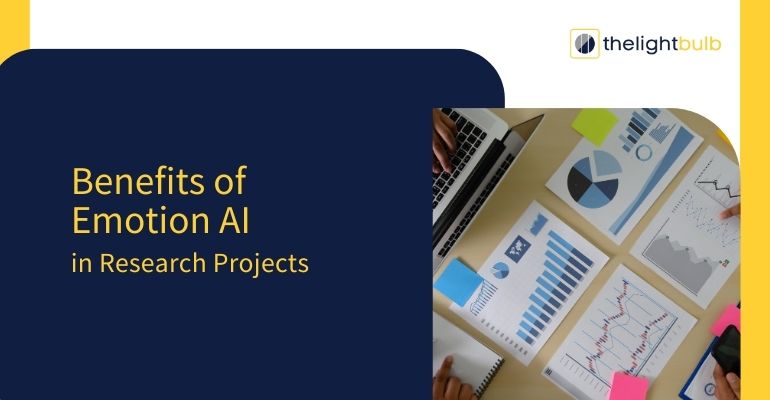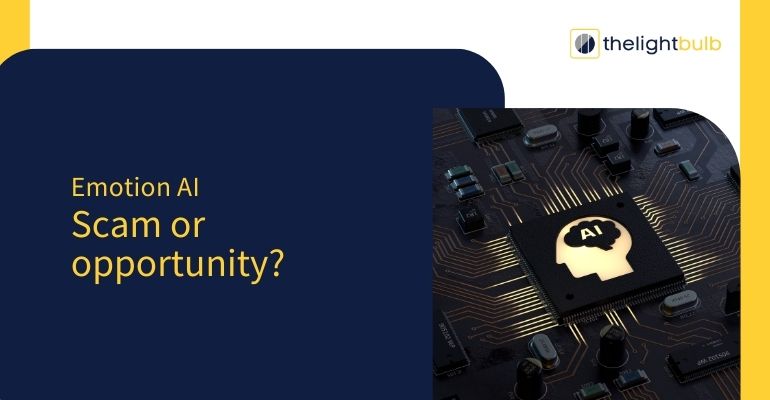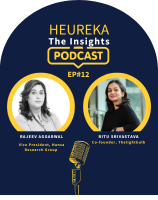
Why Emotion AI is the New Market Research Trend to Watch Out For?
The use of AI in extracting consumer insights and decoding consumer behavior is a long-standing proposition. One that is flooded with speculations and doubts regarding the efficacy of the process. Scientists and AI tech proponents have always been interested in implementing AI in market research, and emotion ai is the most promising step toward this goal.
Emotion AI is a subspace of AI that combines real-time emotion tracking with data processing to extract genuine insights from consumers, based on their emotional state.
- Combining techniques like facial muscle tracking, conversational intelligence, and eye tracking, emotion AI can record, analyze, and predict consumer emotions and allow businesses to make more consumer-conscious decisions.
- Emotion AI draws its foundation from Rosalind Picard’s research paper titled “Affective Computing” which defined emotion ai/affective computing as “the science of recognizing, interpreting, processing, and simulating human expressions.”
The impetus for better consumer research lies within the intersection of extracting emotion-centric insights and implementing them to enhance the consumer experience.
The Current Market Research Scenario
Market research provides the necessary insights for designing better products, optimizing the UI/UX of digital products, and creating a marketing strategy that’s consistent with the brand’s target audience to attract quality leads and maintain a high conversion rate. Market research is a powerful tool for businesses, as it steers them in the right direction during the initial phase and offers them a holistic view of consumer preferences.
But the current market research methodologies do not take into account the real-time emotional activity of the consumers. The real problem lies with the genuineness of the data obtained from conventional market research settings. As respondents are aware of the scenario and may give dishonest feedback on a whim, there’s no way to track emotional state and body language to differentiate between honest and dishonest responses.
The most common market research methodologies in the current landscape are-
- Surveys- According to a poll conducted by Hotjar with 2,000 customer experience(CX) professionals, surveys came out to be the most commonly used market research avenue. Surveys are a list of questions curated by CX professionals to gauge consumer preferences and utilize them to optimize a business for maximum output.

- Interviews- Interviews are the most insightful avenue for market research as the interviewer can track behaviours and eye movements to extract additional insights. The questions asked in interviews are mostly similar to survey questions.

- Focus Groups- Focus groups are carefully curated bands of people actively managed by an experienced moderator. The conversions in focus groups revolve around the product, user experience, and the market, as the moderator picks insights from among the responses. Focus groups are expensive to implement and are not recommended for new businesses developing their first product, as they could fall victim to moderator bias or dominance bias.

- Observation- Customer observation sessions are a simpler and more affordable alternative to focus groups where someone from the company observes an ideal client interact with their product in a natural setting. It facilitates a truer insight as there’s no external influence on the consumer. The only downside of this method is that the observer can just observe actions, not thoughts.

For a detailed understanding of conventional market research practices, you can read this 4-step guide to market research
Although these methodologies are widely used across the spectrum and offer actionable insights, one important observation can be made here. The real-time emotional state of the consumers is not being tracked in any of these methods, not even in interviews, or focus groups. Someone could easily lie about a product in an interview and reduce the quality of the insights.
Similarly, surveys are rarely answered with 100% honesty because the incentives for taking a survey are aligned with completing the survey. And without mixing conversational intelligence with conventional market research methodologies there’s no way to ensure the genuineness of the response. Emotion AI offers a gateway to a more genuine set of responses and therefore, a richer and more valuable insight avenue.
Emotion AI and Market Research
A 2021 report by Gartner revealed that more than 27% of the survey respondents see AI as the next big opportunity for organizations to improve their customer experiences. This is because most buying decisions are made subconsciously based on instantaneous emotions. Therefore, it’s important to consider the emotional state of a consumer during market research, because insights derived from advanced AI-based techniques like conversation intelligence, facial coding, and eye tracking reflect the true preferences of a consumer and the likelihood of positive interactions between the product and the consumer.
Facial coding is one of the most advanced techniques employed by emotion ai based market research frameworks. It analyzes facial muscles to determine the mood of the consumer. Other techniques include eye-tracking, conversational intelligence, head-position monitoring, audio tonality, and speech transcription.
A closer view of these techniques reveals why they’re enormously effective in market research.
FACS(Facial Action Coding System)
FACS is a system based on Paul Ekman’s report under the same name. It is a framework that breaks facial expressions into individual muscle movements, where each muscle movement is described as an Action Unit(AU). The FACS framework categorizes expressions into 7 universal emotions happiness, sadness, surprise, fear, anger, disgust, and contempt.

It is one of the most important components of emotion ai. It makes emotions scalable and therefore much easier to incorporate into consumer insights. FACS is being actively used across scientific and social settings. Animators like Pixar, Disney, Apple, and EA Sports actively incorporate FACS insights into their animations to make them look more realistic.
With FACS, real-time, or recorded consumer interactions can be scanned for emotional insights and they can be used to improve product designs or UI/UX experiences.
Eye-Tracking and Conversational Intelligence
Eye tracking is one of the most reliable features of emotion ai. It can be used to measure the activity of a consumer while interacting with a digital product. It creates an attention heatmap across to determine areas with maximum attention span. Eye tracking can be clubbed with conversational intelligence(the ability to read emotions and draw insights) to understand the true nature of interactions.

For instance, a high-intensity zone in an eye-tracking heatmap coupled with a positive expression from the user represents positive UI/UX elements and vice versa. Eye tracking and conversational intelligence can extract insights from both real-time remote interactions and recorded sessions.
Eye tracking coupled with conversational intelligence can be used for testing ads, videos, or visuals to locate areas that need improvement.
The advantages of using Emotion AI in Market Research
Insights derived using emotion ai are most certainly richer and more actionable. Verbal insights sure can be extracted from conventional market research methodologies, but emotion ai-powered market research tools can extract non-verbal insights as well and club them with verbal insights to generate deeper, more genuine insights.
Emotion AI-driven insights are:
- More Accurate: As already mentioned above, emotion ai combines verbal and non-verbal insights to generate more accurate insights. Emotion AI insights are accurate more than 90% of the time. Metrics like emotions, attention, engagement, and awareness are easily incorporated into insights using emotion-AI.
- No Bias: Moderator bias, respondent bias, group bias, information bias, dominance bias, or any other individual biases are removed from insights when emotion ai is used. Unbiased insights are healthiest and more productive than biased insights, it promotes a more pluralistic design change.
- Infinite Scalability: Emotion AI is not restricted by datasets. Modern-day computers are capable of processing trillions of bytes of data per second which makes them a powerful data processing tool, and as you feed more and more data into the emotion ai system, the reported insights become more accurate.
- Clean and Actionable: Emotion AI-driven insights are super sleek and actionable. They highlight the exact portions of an article, video, visual, or digital product that needs change. A visual heat map coupled with emotional insights can easily reveal the pain points of a consumer.
Understanding consumers is pivotal for a business to create scalable solutions and emotion ai can help you do that. You can read our blog on The Role of Emotion AI in Understanding Consumers/a> to understand how.
About Lightbulb

Lightbulb.ai is an engagement analytics and emotion AI platform that provides real-time emotion AI and engagement analytics tools for real-time or recorded remote interactions between the users and the product. Using emotion-tracking tools like facial tracking, head position, audio tonality, and speech transcription, it is capable of producing smart emotional insights. These insights are highly actionable and can help businesses craft a better user experience for their customers. It is browser-based and can be integrated with any system through in-build APIs and SDKs without any VC tools whatsoever.
You can learn more about us and how we can help you by visiting www.thelightbulb.ai, or you canbook a call with us to consult your user experience issues with our experts. We would love to carry this conversation forward!











